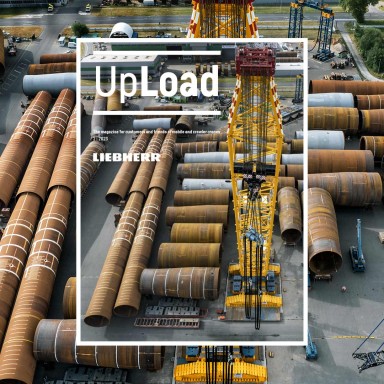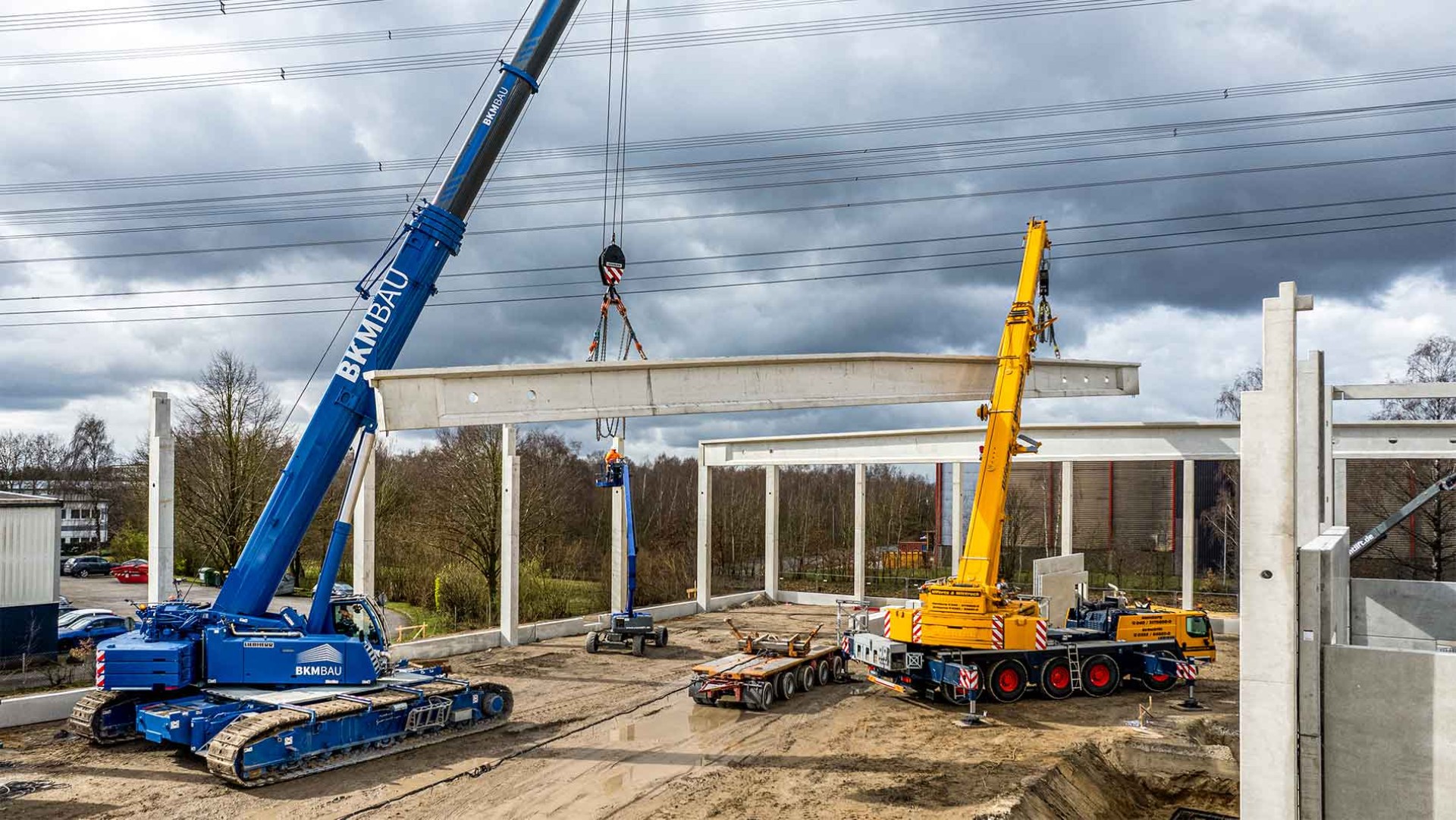
6 minutes - magazine 02 | 2023
Under high voltage
Building a warehouse almost ten metres high from prefabricated concrete elements is nothing unusual in itself. However, this routine job becomes a daring undertaking if the project must be carried out directly under several live high voltage lines with a ground clearance of less than 19 metres.
For concrete construction sites, thereʼs nothing better.
An LTR 1220 enables an industrial building to be constructed directly below power lines
In Norderstedt near Hamburg, BKM Bau Beteiligungs-GmbH KG (BKM), which specialises in industrial and commercial construction, has managed to do just that. 900 precast concrete elements were produced at BKM in Nienburg, delivered and installed in just nine weeks. The star of the show was a Liebherr LTR 1220 telescopic crawler crane, which delivered an electrifying performance.
“To put it bluntly, we wouldnʼt have been able to realise this construction project just a few metres under the high voltage line without the LTR 1220.” Boris Cordes, assembly manager at BKM and the person responsible for the project, is visibly satisfied with the rapid progress of the construction work. And with his new crane. The graduate engineer is delighted that his plan, which he came up with more than a year ago, has worked. He convinced his boss and company owner Sebastian Tinzman that it would be better to buy the most powerful Liebherr telescopic crawler crane instead of the planned LTM 1230-5.1. However, they had previously always managed with mobile cranes and Cordes certainly had to do some convincing. “But now, after completing five construction projects with our LTR 1220, I can report consistently positive results,” says Tinzman.
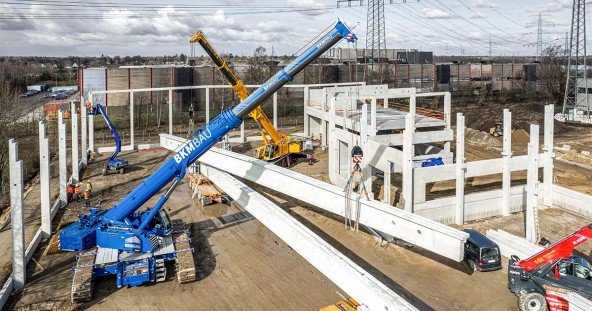
Manoeuvres with a bulky load - Underneath the power lines, the 36 metre long component is threaded through the gap between the cranes. The working range limiter, which is integrated as standard in the LICCON control system, can prevent too much luffing upwards or telescoping by automatically deactivating the working movement. An LTM 1130-5.1 mobile crane from the heavy haulage and crane logistics contractor Ulferts & Wittrock lends a hand.
Only six metres of usable height above the building
Back to the construction site and Boris Cordes. Shortly before the planned completion of his customerʼs 11,000 square metre warehouse, everything is going according to plan on site in Norderstedt. The project is also on schedule, a comparative rarity in this industry. The crane and the men in its assembly team have already mastered the trickiest spots with the lowest hanging power lines. “The pulley head height for the crane was limited to a maximum of 15.7 metres here. We had to maintain the required safety distance from the power lines,” says Cordes, “so in some places we only had a usable height of six metres above the building.”
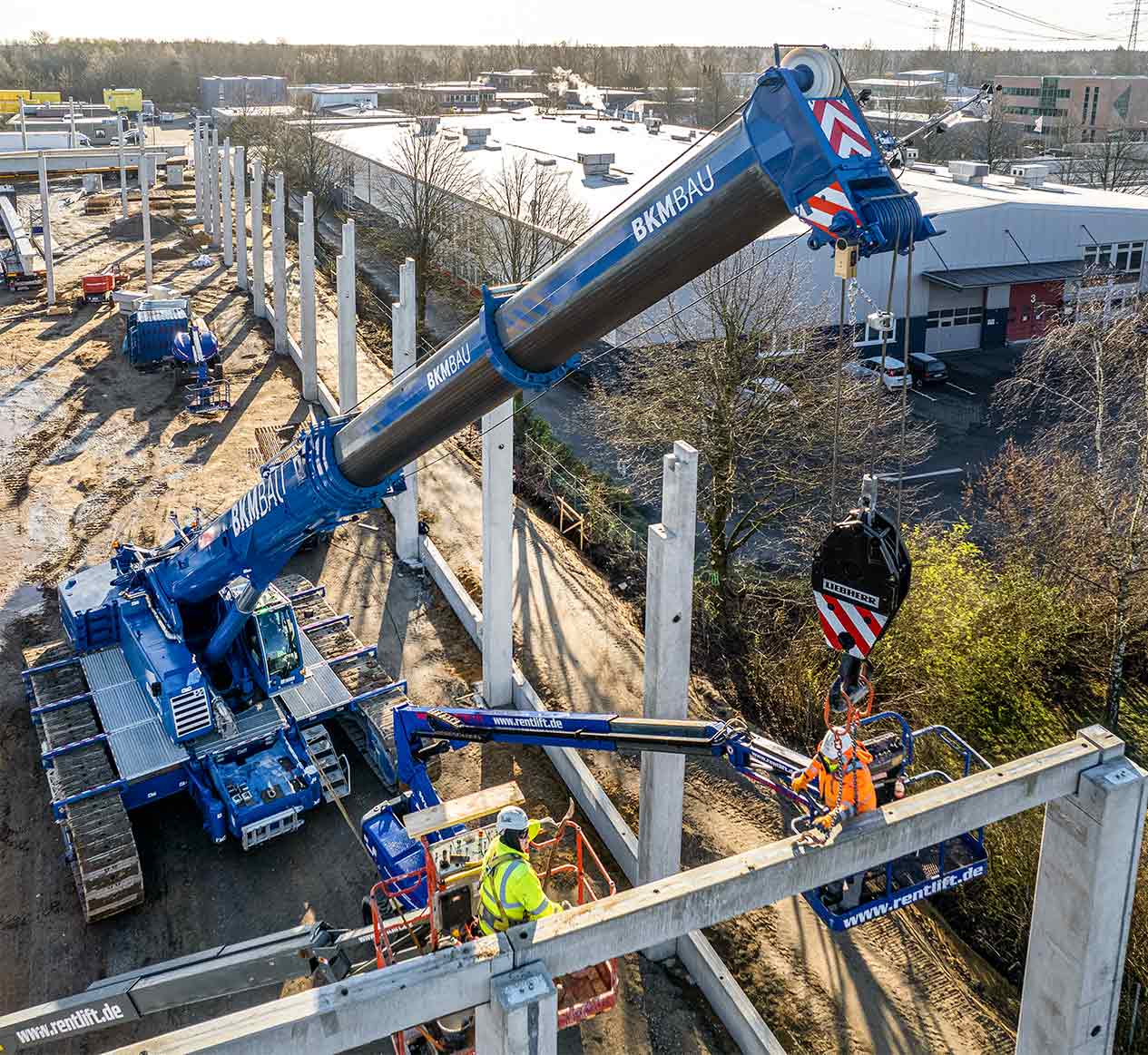
Perfect! - Installing trusses at a height of ten metres: childʼs play for the LTR 1220. At the time, the 60 tonne girder was the heaviest element ever moved on the hook of BKMʼs telescopic crawler crane.
The most difficult problem, but one that was cleverly solved, was the assembly of the mighty, 40 tonne trusses. Together with a Liebherr mobile crane, the LTR 1220 lifted the 36 metre long concrete elements from the heavy transporter. Due to the limited space available, however, the long floor trusses could only be delivered at right angles to the direction of installation. The telescopic crawler crane had the task of picking them up at the far end and, after threading and swivelling the bulky components between the two machines, driving with its load to the installation site under the high-voltage lines. After that, positioning the beams on the pillars was fairly routine.
“Since all the supports for the warehouse had already been erected, it was already quite tight when handling the long prefabricated parts,” explains Matthias Bachmann. He sits at the wheel of the blue-painted LTR 1220. Somehow, the Prenzlau native and professional crane driver seems almost at one with his equipment. He wouldnʼt add a thing to his new machine. “Control, camera system, mobility, precision – everything is really top notch,” he enthuses. Since he took delivery of the tele-crawler eight months ago, there has not been a single period of downtime caused by difficulties with his crane. “990 operating hours and no problems, thatʼs already massive. And in any case, thereʼs nothing better for concrete construction sites than a crawler crane with a telescopic boom.”
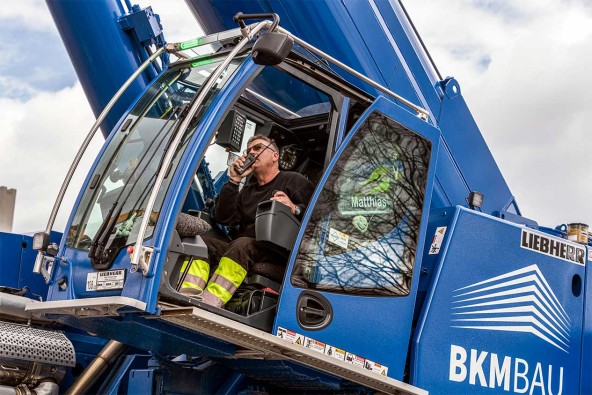
Matthias Bachmann - Crane operator BKM
“At least 20 per cent faster”
“Precision, flexible manoeuvring, even with a load, is of course the major advantage of this crane,” explains Cordes. “The crane can simply drive a short distance to a newly arrived heavy transport vehicle to unload it. And my crane team has significantly less stress due to the fast load handling and simple procedures on the site. If the crane is in the way, it simply moves aside. There is also no need for time-consuming relocations as with a mobile crane. This, in turn, shortens the waiting time for our fitters. With the LTR, we are much faster than we were before with mobile cranes. At least by 20 per cent,” he estimates. But Boris Cordes is quite sure of one thing: “Buying the LTR 1220 was the best decision we could have made. The crane is simply outstanding.”
This article was published in the UpLoad magazine 02 | 2023.

